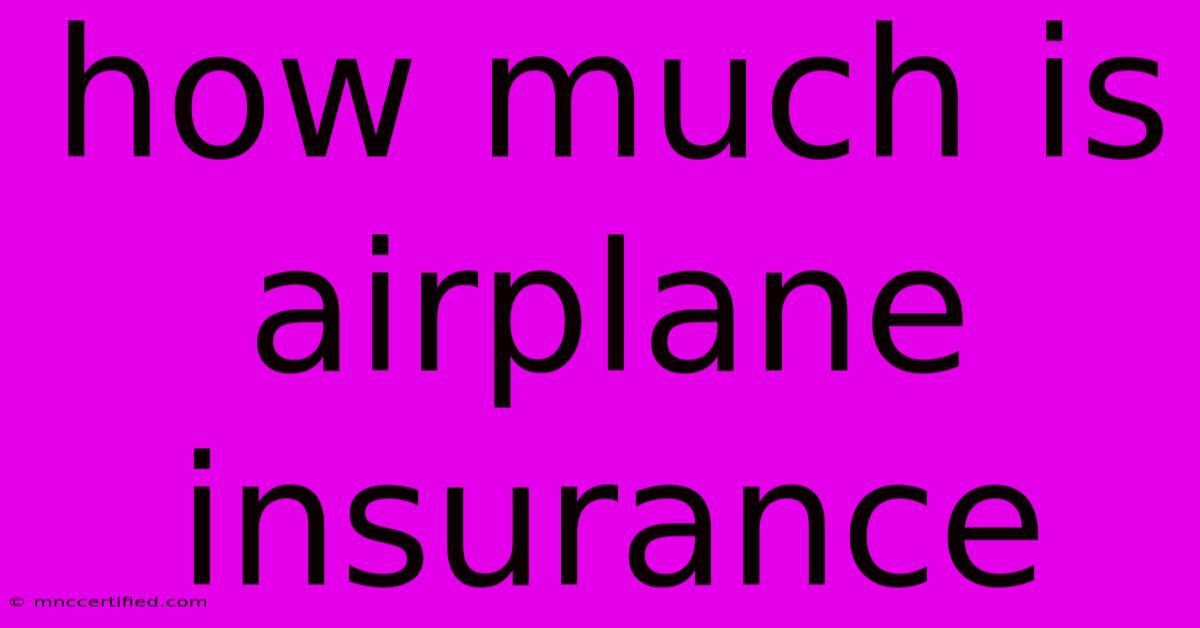How Much Is Airplane Insurance

Table of Contents
How Much is Airplane Insurance? A Comprehensive Guide
The cost of airplane insurance is a complex issue, varying wildly depending on numerous factors. There's no single answer to "how much is airplane insurance?" Instead, think of it as a highly personalized calculation. This guide breaks down the key elements influencing the price, helping you understand what to expect and how to get the best coverage for your needs.
Factors Determining Airplane Insurance Costs
Several factors significantly impact the premium you'll pay for airplane insurance:
1. Type of Aircraft:
- Size and Value: A small, single-engine Cessna will cost far less to insure than a large, multi-engine aircraft or a private jet. The higher the aircraft's value, the higher the premium.
- Age and Condition: Older planes generally command higher premiums due to increased risk of mechanical failure. A well-maintained aircraft, with meticulous records, will attract lower rates than a poorly maintained one.
- Type of Aircraft: The specific make and model influence the cost. Some aircraft have better safety records and lower maintenance costs, leading to lower insurance premiums.
2. Pilot Experience and Qualifications:
- Flight Hours: Pilots with extensive flight hours and a clean safety record will receive lower premiums than less experienced pilots. Insurance companies assess risk based on the pilot's history.
- Type Ratings and Certifications: Specific ratings and certifications, such as instrument ratings or commercial licenses, can influence the premium. Higher qualifications often translate to lower risk.
- Accident History: A history of accidents or incidents will significantly increase insurance costs.
3. Usage and Purpose:
- Personal vs. Commercial Use: Commercial use (e.g., flight instruction, air taxi services) carries significantly higher premiums than personal recreational flying. The increased risk associated with commercial operations translates to higher insurance costs.
- Flight Frequency: How often the aircraft is flown impacts the premium. More frequent flights increase exposure to risk and thus the cost.
- Geographical Location: Flying in areas with challenging weather conditions or high traffic density will generally result in higher premiums.
4. Coverage Type and Limits:
- Liability Coverage: This covers damages caused to third parties (people or property) due to an accident. Higher liability limits will result in higher premiums.
- Hull Coverage: This protects the aircraft itself against damage or loss. The extent of coverage (e.g., agreed value vs. actual cash value) will affect the cost.
- Other Coverage Options: Additional coverages, like passenger liability, legal defense, or emergency services, will add to the overall premium.
5. Insurance Provider:
- Reputation and Financial Strength: Choosing a reputable insurance provider with a strong financial standing is crucial. However, premiums can vary between providers, so comparing quotes from multiple companies is essential.
Getting Quotes and Finding the Right Coverage
To determine how much airplane insurance will cost you, you'll need to contact several aviation insurance providers. Be prepared to provide detailed information about your aircraft, pilot qualifications, and intended use. This information allows them to accurately assess your risk profile and provide a tailored quote.
Tips for finding affordable airplane insurance:
- Shop around: Compare quotes from at least three different providers.
- Maintain a clean safety record: A history of safe flying significantly impacts premiums.
- Improve pilot qualifications: Additional training and certifications can lead to lower premiums.
- Consider your coverage needs carefully: Don't over-insure, but ensure you have adequate coverage to protect yourself and your assets.
- Regular aircraft maintenance: Proper maintenance reduces the risk of accidents and can lower premiums.
Conclusion
The cost of airplane insurance is a dynamic calculation influenced by numerous interconnected factors. By carefully considering each element, you can better understand the pricing structure and make informed decisions to secure the best and most cost-effective coverage for your aircraft. Remember to shop around, be transparent with your insurance provider, and prioritize safety to potentially lower your premiums.

Thank you for visiting our website wich cover about How Much Is Airplane Insurance. We hope the information provided has been useful to you. Feel free to contact us if you have any questions or need further assistance. See you next time and dont miss to bookmark.
Featured Posts
-
Rhode Island Renters Insurance
Nov 27, 2024
-
Health Equity Social Protection Webinar
Nov 27, 2024
-
Arsenal Thrash Sporting Cp 5 1 In Europa League
Nov 27, 2024
-
Man Citys Collapse Feyenoords Fightback
Nov 27, 2024
-
Chubbs Link To Dhl Lithuania Crash
Nov 27, 2024